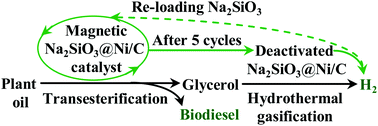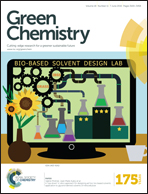Production of biodiesel and hydrogen from plant oil catalyzed by magnetic carbon-supported nickel and sodium silicate
Abstract
A novel magnetic carbon-based nickel and sodium silicate catalyst (Na2SiO3@Ni/C) was prepared by the precipitation of Ni(OH)2 on bamboo powders, pyrolysis and the loading of Na2SiO3, and was used in the co-production of biodiesel and hydrogen. The catalyst had strong magnetism (magnetic saturation, Ms of 15.7 Am2 kg−1) from the Ni and basicity (3.18 mmol g−1) from the Na2SiO3 for magnetic separation and biodiesel production. In the presence of Na2SiO3@Ni/C, a biodiesel yield of 98.1% was achieved from soybean oil under the best conditions (9/1 methanol/oil molar ratio, 7 wt% catalyst, 65 °C for 100 min), optimized by single-factor experiments. The catalyst was cycled 4 times with biodiesel yields >93%, but the yield dropped to 80.9% with a 85.3% catalyst recovery rate in the fifth cycle. The deactivated catalyst, after 5 cycles, catalyzed the hydrothermal gasification of a biodiesel by-product (crude glycerol) at 350 °C for 5 min with a gasification rate of 80.1% and 82.7% H2 purity. The role of Ni is to catalyze the H2 production while the role of Na2SiO3 is to absorb CO2 to achieve high H2 concentrations. After gasification, the structure of the Ni/C changed slightly and can still be cycled to load Na2SiO3 for biodiesel production and subsequent gasification.


 Please wait while we load your content...
Please wait while we load your content...